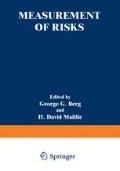Abstract
The identification of susceptible subpopulations serves basic as well as applied purposes. The biological properties by which a subpopulation differs from less susceptible individuals furnish important clues about the basic mechanisms by which an environmental agent impinges on biological material of all organisms (e.g., repair deficiencies shed light on repair in general); they also provide information on the pathways between the original interaction and the finally expressed endpoint. From a more applied point of view, the existence of susceptible subpopulations may lead to limitations in permissible doses of an environmental agent. Where a subpopulation cannot be physically separated from the main population, such limitations must be to the overall population. Alternatively, the susceptible subpopulation may have to be restricted from certain environments, e.g., the workplace — a procedure that can have social and legal implications.
Access this chapter
Tax calculation will be finalised at checkout
Purchases are for personal use only
Preview
Unable to display preview. Download preview PDF.
References
Blot, W. J.: Growth and development following prenatal and childhood exposure to atomic radiation. J. Radiat. Res. Suppl., 82-88 (1975)
Dobson, R. L. and Kwan, T. C: The tritium RBE at low-level exposure — variation with dose, dose rate, and exposure duration. Current Topics in Radiation Research Quarterly 12:44–62 (1977)
Dobson, R. L., Koehler, C. G., Felton, J. S., Kwan, T. C., Wuebbles, B. J., and Jones, C. L.: Vulnerability of female germ cells in developing mice and monkeys to tritium, gamma rays, and polycyclic aromatic hydrocarbons. In Developmental Toxicology of Energy-Related Pollutants, Ed. by D. D. Mahlum et al. Techn. Info. Center, U.S. Dept. of Energy, CONF-771017 pp. 1-14 (1978)
Hicks, S. P. and D’Amato, C. J.: Low dose radiation of the developing brain. Science 141:903–905 (1963)
Kameyama, Y., Hoshine, K. and Hayashi, Y.: Effects of low-dose X-radiation on the matrix cells in the telencephalon of mouse embryos. In Developmental Toxicology of Energy-Related Pollutants, Ed. by D. D. Mahlum et al. Techn. Info. Center, U.S. Dept. of Energy, CONF-771017, pp. 228-236 (1978)
Miller, R. W. and Mulvihill, J. J.: Small head size after atomic irradiation. Teratology 14:355–358 (1976)
Oakberg, E. F.: Gamma-ray sensitivity of oocytes of immature mice. Proc. Soc. Exptl. Biol. Med. 109:763–767 (1962)
Peters, H.: Radiation sensitivity of oocytes at different stages of development in the immature mouse. Radiat. Res. 15:582–593 (1961)
Russell, L. B.: X-ray induced developmental abnormalities in the mouse and their use in the analysis of embryological patterns. I. External and gross visceral changes. J. Exptl. Zool., 114:545–602 (1950).
Russell, L. B.: X-ray induced developmental abnormalities in the mouse and their use in the analysis of embryological patterns. II. Abnormalities of the vertebral column and thorax. J. Exptl. Zool., 131:329–395 (1956)
Russell, L. B.: Effects of low doses of X-rays on embryonic development in the mouse. Proc. Soc. Exp. Biol. Med. 95: 174–178 (1957)
Russell, L. B.: Sensitivity patterns for the induction of homeotic shifts in a favorable strain of mice. Teratology 20:115–125 (1979)
Russell, L. B.: Sensitivity of the homeotic-shift prescreen for environmental teratogens. Teratology 19:45A (1979)
Russell, L. B., Badgett, S. K., and Saylors, C. L.: Comparison of the effects of acute, continuous, and fractionated irradiation during embryonic development. Internat. J. Radiation Biol., Suppl.: 343-359 (1960)
Russell, L. B. and McKinley, Jr., T. W.: Application of a sensitive in vivo teratological system to the testing of Benzo(a)pyrene. In Developmental Toxicology of Energy-Related Pollutants, Ed. by D. D. Mahlum et al. Techn. Info. Center, U.S. Dept. of Energy CONF-771017, pp. 175-187 (1978)
Russell, L. B. and Russell, W. L.: Radiation hazards to the embryo and fetus. Radiology 58:369–376 (1952)
Russell, L. B. and Russell, W. L.: An analysis of the changing radiation response of the developing mouse embryo. J. Cellular Comp., Physiol., 43, Suppl. 1:103–149 (1954)
Russell, W. L., Russell, L. B., Steele, M. H., and Phipps, E. L. Extreme sensitivity of an immature stage of the mouse ovary to sterilization by irradiation. Science 129: 1288 (1959)
Wright, S.: An analysis of variability in number of digits in an inbred strain of guinea pigs. Genetics 19:506–536 (1934)
Wright, S.: The results of crosses between inbred strains of guinea pigs, differing in number of digits. Genetics 19: 537–551 (1934)
Author information
Authors and Affiliations
Editor information
Editors and Affiliations
Rights and permissions
Copyright information
© 1981 Plenum Press, New York
About this chapter
Cite this chapter
Russell, L.B. (1981). Utilization of Critical Periods During Development to Study the Effects of Low Levels of Environmental Agents. In: Berg, G.G., Maillie, H.D. (eds) Measurement of Risks. Environmental Science Research, vol 21. Springer, Boston, MA. https://doi.org/10.1007/978-1-4684-4052-2_8
Download citation
DOI: https://doi.org/10.1007/978-1-4684-4052-2_8
Publisher Name: Springer, Boston, MA
Print ISBN: 978-1-4684-4054-6
Online ISBN: 978-1-4684-4052-2
eBook Packages: Springer Book Archive

